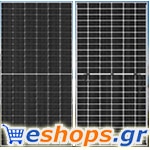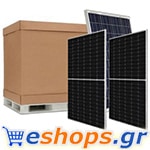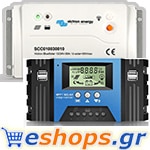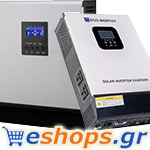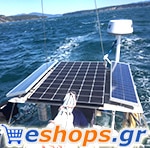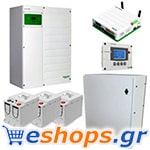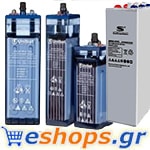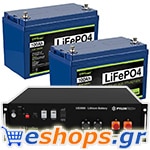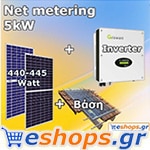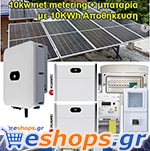How Do PVs Work?
Photovoltaic Information
Sunlight is essentially small packets of energy called "Photons". So the photons of sunlight have different amounts of energy, depending on the wavelength of the solar energy spectrum. So when photons "collide" with a photovoltaic cell, some are reflected, some pass through it, and some are simply absorbed. So the latter (which are absorbed) are the ones that create the electric current.
The photovoltaic panels are based on the solar cell, a thin semiconductor processed on a flat surface.
The solar photovoltaic cells are properly grouped and assemble the photovoltaic panels or generators, standard power from 10W to 300W. Photovoltaic generators are electrically connected to each other and photovoltaic arrays (pv-arrays) are created.
The Technologies of Solar Photovoltaic Elements-Photovoltaic cells
Photovoltaic panels are divided into two main categories:
1. PHOTOVOLTAICS PVC CRYSTAL
- Monocrystalline silicon photovoltaics with frame efficiencies of 14,5% to 21%
- Monocrystalline silicon photovoltaics with frame efficiencies of 13% to 14,5%
2. PhiTHIN FILM PV METAL VOLTAGE
- Photovoltaics from amorphous silica aSi with nominal efficiency ~ 7%.
- Photovoltaics from Copper Silicates CIS / CIGS, with nominal efficiency from 7% to 11%.
Silicon (Si) is the basis for about 90% of world production of photovoltaics. Silicon, depending on its processing, gives monocrystalline, polycrystalline or amorphous materials, from which the photovoltaic elements are produced. Thin materials are one way to reduce costs and increase their efficiency. The technology of thin film photovoltaic panels (thin film) is still in a developing stage since with different processing methods and the use of different materials is expected to increase efficiency, stabilize their characteristics and increase market penetration. Today, however, they are the cheapest choice of photovoltaic panels.
How PVs Work - STRUCTURE ANALYSIS
A photovoltaic system consists of the following components:
-
The photovoltaic generator with the support base and maybe (tracker), solar tracking system.
-
Batteries - photovoltaic accumulators
-
Charging regulator to control and protect the batteries.
-
Dc voltage converter (12v / 24v / 48v) inverter for transformation to 220V AC.
TYPES OF PHOTOVOLTAIC SYSTEMS
There are three categories of photovoltaic systems, the interconnected (solar-pv) with the PPC network and the autonomous. The simplest form of the second of the two consists simply of a photovoltaic generator, which supplies a load of direct current whenever there is sufficient brightness. This type of system is common in home or agricultural applications. In other cases the photovoltaic system provides the possibility of storing energy in the batteries. An electric power converter is often included, such as in the event that AC power is required to exit the system. In some cases the system contains a backup generator or wind turbine (hybrid photovoltaic system).
The grid-connected photovoltaic systems can be subdivided into those in which the grid acts merely as an auxiliary power supply (backup grid) and those which may also receive additional power from the photovoltaic generator (interactive network). Inside the photovoltaic stations all the generated power is fed to the grid.
How PV Works - BASIC UNITS
Usually the photovoltaic solar cells in a basic unit are interconnected in a series. This is due to the electrical characteristics of each solar photovoltaic cell. A standard (4 inches in diameter) crystalline silicon or a (10 cm * 10 cm) polycrystalline element will provide power between 1 and 1.5 under normal conditions watt, depending on the performance of the solar cell. This power is usually supplied at 0.5 or 0.6 V. Since there are very few applications running at this voltage, the immediate solution is to connect the solar cells in series.
The number of electric photovoltaic cells inside a basic unit is regulated by the voltage of the basic unit. The nominal operating voltage of the photovoltaic system usually has to match the rated voltage of the storage subsystem. Most of the basic photovoltaic modules, manufactured industrially, have fixed devices, which can work even with 12Volt / 6Volt / 2Volt batteries. Predicting the possibility of overvoltage in order to charge the photovoltaic battery and compensate for a lower output, under conditions lower than normal. It has been found that a group of 33 to 36 solar cells in series usually ensures reliable operation.
The three most important electrical characteristics of a basic unit are the short-circuit current, the open-circuit voltage and the maximum power point as a function of temperature and radiation. These characteristics are similar to the I-V of a solar cell, but some specific features need to be clarified.
USES OF PHOTOVOLTAICS
Photovoltaics are devices that produce electricity from the sun's radiation. This electricity is used to power a device or to charge its battery. This technology is widely used in battery-powered pocket microcomputers simply by exposing them to light.
Photovoltaics are often used in arrays to generate energy on a large scale.
PHOTOVOLTAICS ON ROOFS
In Greece, some subsidized photovoltaic programs have been launched for investments in photovoltaics on roofs, which produce electricity that is resold and introduced into the public transmission networks of PPC. These programs aim to diversify electricity production and its gradual decoupling from oil.
Temperature is an important operating parameter of a photovoltaic system. As we have seen the temperature coefficient for the open circuit voltage is approximately equal to -2.3 mV / ◦C for each solar cell. The voltage coefficient of a basic unit is therefore negative and very large since 33 to 36 solar cells are connected in series. The current factor, on the other hand, is positive and small at about +6 μA / ◦C per square centimeter of the base unit. Therefore, only the voltage change with respect to m ?? this temperature is taken into account mainly for practical calculations while for each basic unit consisting of nc solar cells connected in series equal to:
As with any solar photovoltaic panel, the short-circuit current ISC of a basic unit is proportional to the radiation and will therefore vary during the day in the same way. Since voltage is a logarithmic function of current, it will also be logarithmically dependent on radiation. Thus, during the day the voltage will change less than the current. In the design of the photovoltaic generator it is common to neglect the voltage change and to receive the short-circuit current proportional to the radiation.
The operation of a basic photovoltaic module should be as close as possible to the point of maximum power. It is an important feature of the basic unit, that the voltage of the point of maximum power Vm is almost independent of radiation. The average value of this voltage during the day can be estimated at 80% of the open circuit voltage under normal radiation conditions. This feature is useful for designing the device's power control unit.
NOCT (usually between 42 ° C and 46 ° C) is then used to determine the temperature of the solar electric photovoltaic cell Tc during basic unit operation. We usually assume that the difference between Tc and ambient temperature Ta depends linearly on the radiation Gr.
COLLECTION OF SOLAR ENERGY THROUGH PHOTOVOLTAIC SYSTEMS
An important part in the installation of photovoltaic panels is to fix the fixed bases with an angle of 30-35 degrees and south orientation or the orientations of the photovoltaic trackers to follow (track) the movement of the sun.
In most devices the basic photovoltaic units fastened to ?? a fixed sloping plane facing the equator. This has the virtue of simplicity, i.e. no moving parts and low cost. The optimal angle of inclination depends mainly on the latitude, the ratio of diffuse radiation on the site and the type of load.
How PV Works - SUPPORT SYSTEMS
By mounting the photovoltaics on a system with two solar monitoring shafts, up to 25% more solar energy can be collected during one year, compared to the installation of a fixed slope. However, this increases the complexity and results in lower reliability and higher maintenance costs. The single axis tracking (tracking) Tracker is less complex but shows less profit. Orientation can be adjusted manually, where the job offer is available, thus increasing any earnings. It has been estimated that in sunny climates a flat moving plate device that is properly adjusted to face the sun twice a day and receive the appropriate judgment four times a year can capture 95% of the energy you collect with a fully automated two-axis monitoring system.
The monitoring system is especially important systems that operate under concentrated sunlight. The structure of these photovoltaics extends from a simple design based on side-view magnifying mirrors to centralized systems, which use state-of-the-art optical techniques to increase light input to solar photovoltaic cells. in a few orders of magnitude. These systems must provide for an important fact, that is, by concentrating solar energy they reduce the angular aperture of the rays, which the system can accept. Monitoring becomes necessary as soon as the concentration ratio exceeds about 10 and the system can only convert the direct component of solar radiation.


